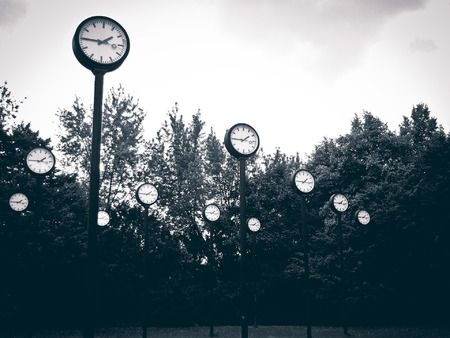Time and Time Again
A surrealist artist, Salvador Dali, once stated that "The only difference between me and a madman is that I'm not mad." He later contradicted himself, "There is only one difference between a madman and me. The madman thinks he is sane. I know I am mad."

There are many reasons why someone like Dali would be considered mad - he was interested in an alternative reality. When he painted, he put himself in a self-induced hallucinatory state. He hypnotized himself in order to paint according to the standards of surrealism art and crack open the world of subconscious craftsmanship. These standards would include attacking anything rational and wanting to retrieve the world of dreams - where the mind can act as irrational as it could in the most nonrestrictive manner.
In some ways, it's similar to waking up after the strangest dream in a most confused state. Surrealist artists wanted to capture the strangeness of dreams - the irrationality of the dreamscape. This attack on the rational began in the late 1910's, with Salvador Dali joining the ranks in 1929 when his father threw him out as a 25-year-old painter and his entire Spaniard village banned him. At that point, he was penniless and a simple outcast. However, his life took a complete turn a couple years later. In 1931, he finished his most famous painting, The Persistence of Memory.

Almost immediately, he became famous, and his painting became the first to be exhibited in the first surrealist exhibition in the US at the Wadsworth Atheneum in Hartford, Connecticut, and later in New York. A couple of years passed, and in 1934, Salvador Dali was expelled from the surrealist movement because of his political opinions against the rise of the fascist leader Francisco Franco in Spain. Nevertheless, he moved to the US and was incredibly welcomed by American Pop Culture Artists.
What was so special about The Persistence of Memory? What made a painting so special, that it not only was immediately successful and well-known but also widely welcomed by different types of artists? An oil on canvas, 9 ½-inch by 13-inch painting, just the size of a small laptop screen, was immediately placed in a museum after it was finished and traveled with Salvador Dali and his wife Gala to many places to be exhibited. Not many artists can claim fame while they were alive, and Dali was one of the few.

Many people, when first encountering this work of Salvador's, would see a quiet, desert landscape with cliffs on the far right. Within it, there is a man-made wooden table, with a dead, grey, withered tree growing out of it. There is an old-fashioned silver pocket watch draped over one of the dead branches, a hand pointing at 6. On the table, there is a small, golden pocket watch, being devoured by ants. On the tip of the counter, there is a large, golden watch with a fly resting on the watch's blue face showing the time of 6:55. Close to the center of the painting, there is a form that is mostly depicted as a self-portrait, or at least part of a self-portrait, of Dali. One can see a nose, a closed eyelid, a forehead, and distinguished lashes. Over this self-portrait is draped another watch with the time of 12:00.
With this very painting, Dali was the first person ever to paint a dreamscape. It included melted clocks and watches, a contorted self-portrait, and a dead tree growing out of a man-made object - showing that it is truly not of this world, but from an absurd environment. Dali himself painted it in a hypnotic state and later stated that there is no possible way for others to understand it, since even he, the artist, couldn't understand what he had created unconsciously.

Nevertheless, let us dive into the subconscious, just like Dali had done while painting. What appealed to the people specifically about this unexplainable painting? I propose that it's the dreams we have. We have all dreamed before, whether it be nightmares, strange dreams, or simple random ones. When we wake up, we have no idea how long our dream lasted - was it the entire night? Did it start once you fell into a deep sleep? Or was it right before you woke up? We truly don't know when we dream, or how long we dream. It just comes to show that time doesn't carry any real weight within the dream world. And when we wake up, our dreams don't affect the outside world, just our inward souls.
In the painting, one can see the sunrise on the cliffs of Dali's childhood - representing permanence. Those cliffs have always been in the world, and the sun rises each morning, yet we as people, dream at night with no time relativity that the world follows. In fact, the painting demonstrates how time rules all of us, even though it's something we try to greatly control - through the creation of calendars, sundials, clocks, watches, and the pursued skill of time-management. But in The Persistence of Memory, time is melting. It shows us as viewers that we can't control time, it's something that we don't understand, yet try to harness to our use.
Time scares everyone - deadlines, due-dates, events, competitions, and eventually, death. A futile attempt in controlling even some of these shows how people enjoy what little control we do have. Yet the painting shows us the hard reality - the disintegration of time, of memories. It shows something we hold true and real in an untrue and unrealistic environment. It has a theme of constant decay and irrationality - a dead tree growing from a man-made object, and ants devouring a metal pocket watch, demonstrating deterioration. It shows how time genuinely doesn't carry power and stability in the world. In fact, it's the power and stability we as people give to the time in our lives.
Even though Salvador Dali claimed that he himself didn't understand his painting and that his inspiration for the draped watches comes from cheese melting under the sun, we as people can learn something from it. Nobody can control time. Some people have tried - and probably felt discouraged afterward. Some people will try and utterly fail. Time is not meant to be controlled. To be set into a man-made schedule, or a year-long planner. Yes - those are helpful, but we need to understand that time is not to be controlled, but rather used.
We need to be able to use our time wisely. Each time we're not working on our priorities, that is time controlling us, and us not using our time. So I challenge and encourage you to use time, and know that you will survive when everything seems out of your control; because remember: you're not supposed to control time. Time was gifted to us to use. I'd like to end with a saying from Mother Teresa; "Yesterday is gone. Tomorrow has not yet come. We have only today. Let us begin."
CITATIONS: https://www.pexels.com/search/time/, https://www.phaidon.com/agenda/art/articles/2016/may/10/salvador-dalis-the-persistence-of-memory-explained/

